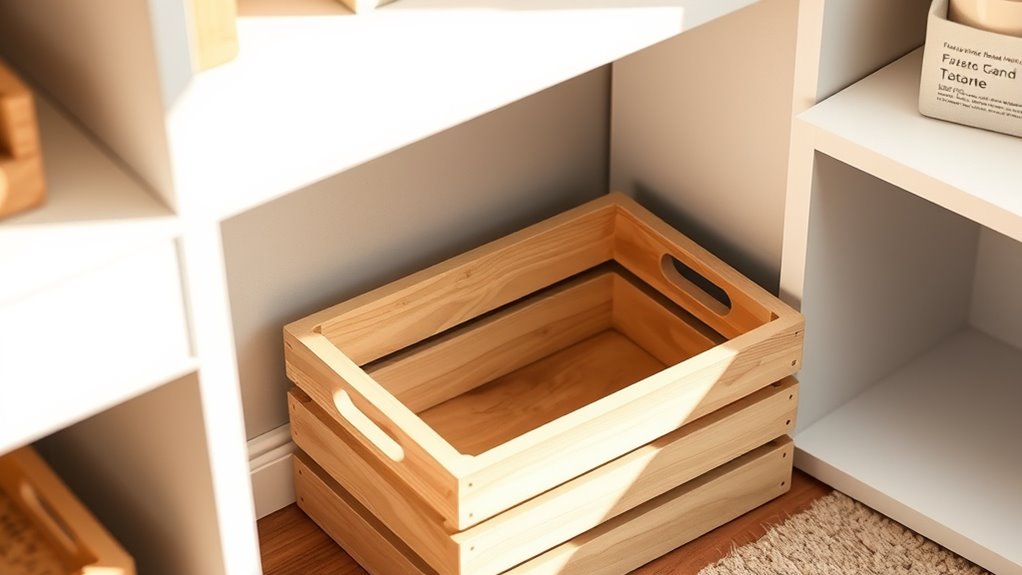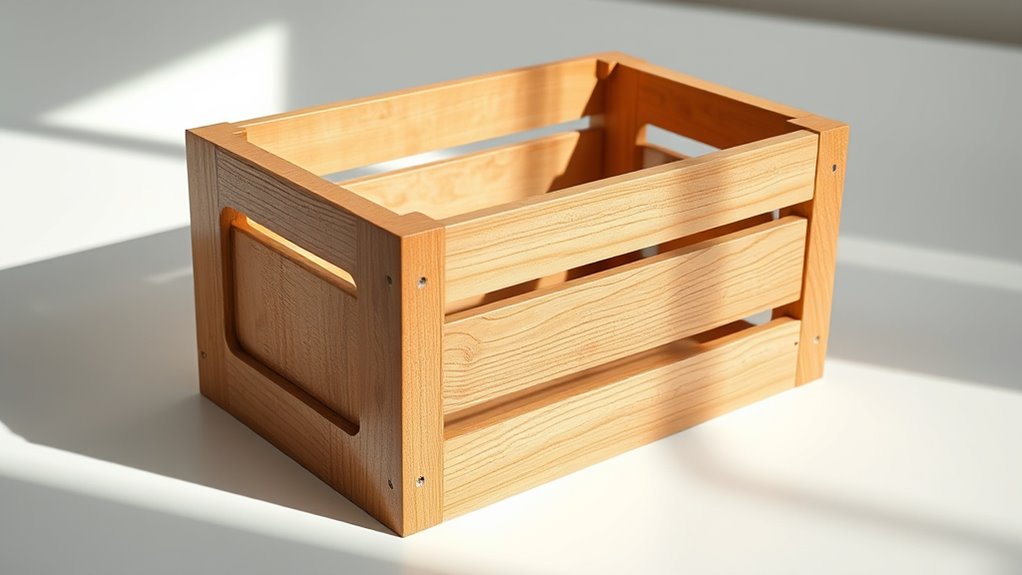To create a compact wood storage crate for small spaces, measure your available area and choose sturdy materials like plywood or reclaimed wood for durability. Design it slightly elevated to prevent moisture damage and include handles for easy relocation. Reinforce joints with rust-resistant hardware and add ventilation for airflow. Seal or paint the wood to withstand weather. Keep it simple yet sturdy—if you want tips on building it efficiently, there’s more to explore.
Key Takeaways
- Measure your available space to customize crate dimensions that fit snugly in small areas.
- Design with compact form and vertical stacking options to maximize storage efficiency.
- Use durable, weatherproof materials like plywood or reclaimed wood to withstand outdoor conditions.
- Incorporate handles or cutouts for easy movement and repositioning in tight spaces.
- Elevate the crate slightly off the ground to prevent moisture intrusion and prolong durability.

If you’re short on space but need a practical storage solution, creating a compact wood storage crate is a smart choice. Not only does it help you organize your firewood efficiently, but it also allows you to maximize the limited area you have. The key to building a successful crate lies in using DIY hardware that’s both sturdy and easy to assemble. With the right tools and materials, you can design a custom storage unit that fits your space perfectly and keeps your wood dry and accessible.
Start by planning your crate’s dimensions. Measure the space where you want to place it, considering the amount of wood you typically store. Keep in mind that a slightly taller or wider design can accommodate future needs. To optimize space, opt for a design that elevates the crate off the ground slightly, preventing moisture from seeping in. Using sturdy plywood or reclaimed wood for the sides and base ensures durability without taking up extra room. You can add handles or cutouts on the sides to make moving it easier, especially if you plan to reposition it later.
Plan your crate’s size to fit your space and future needs, with a slight elevation for moisture protection.
When it comes to DIY hardware, using galvanized screws and brackets is essential. These materials resist rust and withstand outdoor conditions, increasing the lifespan of your crate. Pre-drill holes to prevent splitting and ensure a tight fit. For added stability, consider corner brackets or L-brackets at the joints. These small details reinforce the structure, making it more robust for long-term use. If you want a more polished look, paint or seal the wood to protect it from weather and extend its usability. Incorporating proper ventilation systems within your crate enhances airflow, which is crucial for maintaining dry firewood and preventing mold.
Moreover, selecting appropriate hardware that resists outdoor elements is vital for longevity. Building a compact wood storage crate with DIY hardware isn’t just about saving space; it’s about creating a functional, long-lasting solution tailored to your needs. By carefully planning your design, selecting the right materials, and using simple hardware, you can craft a storage unit that’s both efficient and durable. This approach ensures your firewood stays dry and accessible while freeing up precious space in your yard or garage. Additionally, considering the rust-resistant hardware options will further extend the lifespan of your crate in outdoor environments.
Frequently Asked Questions
What Are the Best Types of Wood for a Small Storage Crate?
You should choose hardwoods like oak or maple for your small storage crate, as they offer a tight wood grain that adds strength and durability. These woods also tend to have good moisture resistance, helping your crate stay in shape over time. Softwoods like cedar or pine are lighter and easier to work with, but guarantee they’re properly sealed to enhance moisture resistance and prolong your crate’s lifespan.
How Can I Customize the Size of My Wood Crate?
Like a modern-day carpenter, you can customize your wood crate by adjusting its dimensions with simple cuts or joint modifications. Use a modular design approach, allowing you to easily change size or shape by adding or removing sections. Measure carefully, then tailor the pieces to fit your space perfectly. This flexibility guarantees your crate stays compact yet functional, perfectly tailored to your needs.
Is It Safe to Use Untreated Wood for Food Storage?
Using untreated wood for food storage isn’t safe because it can harbor bacteria and mold, jeopardizing food safety. Wood treatment involves sealing and finishing the wood to prevent contamination and make it suitable for contact with food. If you want to store food, opt for treated or food-grade wood, and always make certain the surface is smooth and clean. This way, you keep your food safe and avoid health risks.
What Tools Are Needed to Assemble the Crate?
Did you know that proper tool selection can cut assembly time by up to 30%? To assemble your compact wood storage crate, you’ll need a saw, drill, screwdriver, measuring tape, and wood screws. Use assembly tips like pre-drilling holes to prevent splitting and ensuring all pieces align perfectly. These tools make the process smoother, helping you build a sturdy, space-efficient crate quickly and safely.
How Should I Seal or Finish the Wood for Durability?
You should apply wood sealants or protective finishes to enhance durability. Start by sanding the wood smooth, then use a brush or cloth to evenly coat the surface with your chosen sealant, like polyurethane or a water-based finish. Allow it to dry completely between coats. These protective finishes shield the wood from moisture and wear, ensuring your crate lasts longer and remains in great condition.
Conclusion
By building this compact wood storage crate, you’ll maximize your small space efficiently. Imagine fitting all your tools or craft supplies into a container that’s just a foot wide—saving you nearly 40% more room. With a simple design, you can keep your essentials organized and accessible without cluttering your area. Small spaces don’t have to feel cramped; with this crate, you’ll turn tight corners into tidy storage spots effortlessly.











